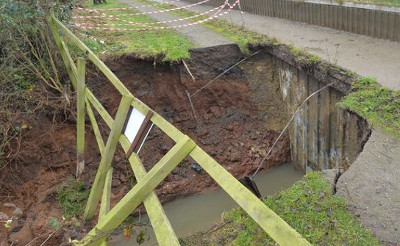TO BETTER understand the possible causes of the breach on the Ashby, I suggest looking no further than the Ashby Canal Association's (ACA) own website, writes James Derrick.
Drawing conclusions from a limited set of evidence is always troublesome, however the most obvious feature from the ACA images is a pipe at the point of the breach under the canal bed. Link
 Steel piling sound and intact
Steel piling sound and intact
The steel sheet piling on the towpath appears sound and intact, even where all of the supporting bank and canal bed has been eroded away. The pipe limits the depth that a few piling sheets could go down to, and this space between the piles and the pipe seems to have funnelled the escaping waters into a very well defined eroded channel towards a nearby field boundary.
Older parts of the canal system suffer from culverts collapsing due to water scour eroding brick mortar, or even wooden box sections finally rotting after hundreds of years. (Photograph credit David Hughes.)
More evidence needed
In this case without more evidence, it is impossible to say if the pipe has failed causing a washout of bank material; or if the canal lining failed where the pipe may have forced it to be shallow with less protection. Large pipes often are protected from ground movement with pea gravel or other loose aggregate—rather the opposite of puddle clay!
I'm not familiar with the soils in the area, but have cruised as far as Market Bosworth and remember gently undulating fields with a pretty well maintained bankside.
Restoration funding is always stretched, but somehow doubt the whole of a canal is at risk . Let's instead celebrate the quick actions by volunteers to install stop planks, loosen boat mooring lines and the resilience of the sheet piling to limit the flow into a nearby field.
Stop lock gates have gone
The double stop lock gates at Marston Junction have been gone for a long time.
(James Derrick 25 years exploring the cut.)
